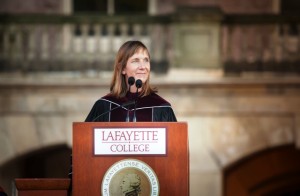
President Alison Byerly presents her inaugural address.
In her inaugural address today, the centerpiece of a historic and memorable Inaugural Convocation, President Alison Byerly envisioned Lafayette as a “dynamic network in which the student experience is energized by ongoing interchange between the educational environment and the world beyond.”
Byerly delivered the address following her formal installation as Lafayette’s 17th president.
“I am excited at the opportunity to lead an institution that I believe can make a significant mark in the changing higher ed landscape,” she said.
Read the full text of her address below
More inauguration coverage:
A day filled with excitement
“New Models for Higher Education” panel discussion
Photo galleries
Inauguration videos:
The day in review
Convocation ceremony
Panel discussion
“What Makes Lafayette….Lafayette?” student contest winner
Among the strengths that drew Byerly to Lafayette is a curriculum that combines traditional liberal arts disciplines with programs in engineering.
“I believe that this combination, very unusual in a college this size, not only benefits individual students, it benefits the College by fostering an institutional ethos that ground the disciplines of concrete problem solving in the necessary skills of open-ended inquiry,” she said.
Lafayette’s strong, deeply rooted sense of community, its history of self-determination, and its ability to balance tradition and change also will be important assets in the years ahead.
In challenging times for higher education, including an “explosion of popular interest” in massive open online courses, Byerly said, the College must be able to justify the value of the “complete package” of elements that make up the Lafayette experience, including the academic program, the athletic and extracurricular opportunities, and the residential environment. The academic program must be rigorous in its disciplinary training but also broadly interdisciplinary, and must be “embedded in a residential environment that supports the community values to which we aspire and connects them to students’ academic and career goals.”
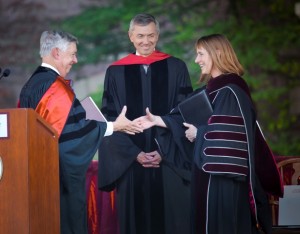
Edward Ahart ’69, left, chair of the Board of Trustees, and Stephen Pryor ’71, vice chair of the board, congratulate President Alison Byerly.
“I believe students will be very attracted to an environment that integrates their academic, social, and professional development into a seamless experience and coherent pathway. Lafayette already displays excellence in each of these three areas. But within the fully connected, immersive environment of a truly three-dimensional liberal arts college, the whole will be stronger than the sum of its parts,” Byerly said.
“In this model, Lafayette will be, not an ivory tower, but an integrated circuit, a dynamic network in which the student experience is energized by ongoing interchange between the educational environment and the world beyond.”
In the installation ceremony, Edward W. Ahart ’69, chair of the Board of Trustees, charged Byerly with the faithful execution of the duties entrusted to her. Stephen D. Pryor ’71, vice chair of the board, and Nancy J. Kuenstner ’75, secretary of the board, presented her with a copy of The Charter and Statues of the College as a symbol of the presidential authority.
“Now, by the authority vested in the Board of Trustees by the Commonwealth of Pennsylvania, I declare you fully admitted to the office to which you have been called,” Ahart said. “I commend to you the welfare of Lafayette College and, with all others here assembled, I congratulate you as you enter upon the presidency of this College.”
John M. McCardell Jr., vice-chancellor and president of Sewanee: The University of the South and former president of Middlebury College, delivered remarks.
Read the full text of McCardell’s remarks
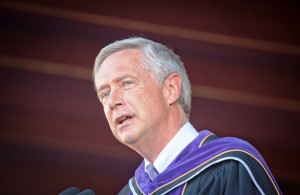
John McCardell Jr., vice-chancellor and president of Sewanee: The University of the South, delivers remarks.
Extending official greetings to the president were Rose Marie L. Bukics, Thomas Roy and Lura Forrest Jones Professor of Economics and acting clerk of the faculty, from the faculty; Arthur J. Rothkopf ’55, president emeritus of the College, from the presidents emeriti; Salvatore J. Panto Jr., mayor of the City of Easton, from the community; Michael E. Prisco ’14 of Pelham, N.Y., a history major and president of Student Government, from the students; Daniel H. Weiss, president of Haverford College and Byerly’s predecessor as Lafayette president, from the colleges and universities represented by delegates at the Convocation; David A. Reif ’68, president of the Alumni Association, from the alumni; and John F. McKnight, dean of intercultural development, from the College’s administration and staff.
The convocation featured music performed by the Lafayette Concert Band, conducted by Kirk O’Riordan, assistant professor of music and director of bands, and the Lafayette Concert Choir and Chamber Singers, conducted by Jennifer Kelly, associate professor of music and director of choral activities. The Inaugural Fanfare was composed by O’Riordan especially for the event.
The academic procession included Lafayette trustees, faculty, students, and alumni as well as delegates from other colleges and universities. Guy L. Hovis, John H. Markle Professor of Geology and Environmental Geosciences, led the procession as Bearer of the Mace.
Alan R. Griffith ’64 and Charles E. Hugel ’51, former chairs of the Board of Trustees, marshaled the trustees. Wendy L. Hill, provost and dean of the faculty, marched at the head of the faculty, and Annette Diorio, vice president for campus life and senior diversity officer, marshaled the student representatives of the College’s academic programs.
Thomas F. McGrail ’55, trustee emeritus, marshaled the delegates from alumni classes. David W. Ellis, president emeritus of Lafayette, marched at the head of the delegates from colleges and universities.
Inaugural Remarks by President Alison Byerly: A Tradition of Change
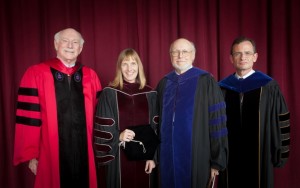
A presidential gathering: Four Lafayette presidents attended the inauguration ceremony- Arthur J. Rothkopf ’55, l-r, Alison Byerly, David Ellis, and Daniel Weiss.
Good afternoon. It is an extraordinary pleasure and privilege to be standing here, in this beautiful place, in the company of so many students, friends, colleagues, and supporters, new and old, as we celebrate a new chapter in the history of a wonderful institution. I never imagined, when I left Pennsylvania 25 years ago for my first teaching job as a newly minted Ph.D., that I would return as a college president; the founders of Lafayette College likely never imagined a female president standing at this podium. Lafayette has seen many changes in its 187-year history. I will suggest in my remarks today that I believe its ability to balance tradition and change will be one of its greatest assets in the years ahead.
Let me begin by thanking John McCardell for his generous and eloquent remarks. It has been a pleasure to have the opportunity to work alongside John during his years at Middlebury, and then to admire his continued leadership on many critical issues in higher ed during his tenure at Sewanee. There are few presidents who know more about the unique dynamics of leading a small residential college.
I’d also like to thank the many colleagues who have offered greetings this afternoon on behalf of their various constituencies. Their presence and remarks serve as a reminder that I take my place as president within a community that extends from the center of this campus to the world beyond: students, faculty, staff, alumni, citizens of Easton, past and fellow presidents and leaders in the world of higher education. I look forward to the opportunity to work individually and collectively with students, to learn how we can make Lafayette as responsive as possible to your passions and challenges; with faculty, to sustain an intellectual community that nourishes not only our students but ourselves; with staff, to create an environment for living and learning that enables you to be effective in supporting the college’s goals and values; with alumni, to broaden understanding of this special place and engage you more deeply in its mission; with the Mayor and citizens of Easton, to continue a productive partnership that grounds the College firmly in a vibrant and authentic community; and with fellow college and university leaders, to advocate on behalf of the kind of quality education that is needed in the country today.
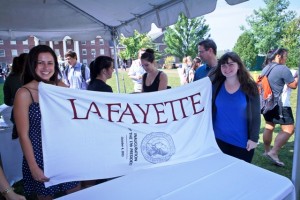
Students pick up their commemorative inauguration beach towel during the dessert social in Anderson Courtyard.
As I said when I was first appointed to this position, I am excited at the opportunity to lead an institution that I believe can make a significant mark in the changing higher ed landscape. I’d like to talk today about the strengths that first drew me to Lafayette, some of the challenges currently facing higher education, and finally about the aspects of Lafayette’s history and identity that give me confidence in its future direction.
Clearly, one of Lafayette’s key strengths is a curriculum that combines traditional liberal arts disciplines with programs in engineering, and I feel the benefits of that unusual combination are even greater than we have recognized. This curriculum not only offers a wide range of choices to students, it benefits the college by fostering an institutional ethos that grounds the disciplines of concrete problem-solving in the necessary skills of open-ended inquiry. Lafayette students learn how to ask big questions, and they also learn how to solve big problems. Moreover, at a time when many liberal arts colleges are struggling to come to terms with a growing trend towards what are seen as more practical majors, Lafayette seems comfortable with an identity that does not view thoughtful education and career aspirations as mutually exclusive.
Indeed, the liberal arts and engineering do not simply peacefully co-exist at Lafayette, they energize each other in unexpected ways. I saw a terrific example of this kind of integration just two weeks ago, when I attended the dedication of an art project erected near the organic garden out at Metzgar Fields. The project is a memorial to a student, Bryan Hendrickson, who passed away in 2011. To honor Bryan’s interests in art, civil engineering, and sustainability, students, working with incredibly committed faculty advisers, designed a water tank that will improve irrigation to the garden, and surrounded it with a scrap metal sculpture that makes it a visible and compelling addition to the site. At the dedication, engineering students described the challenges they experienced in drilling a well and connecting the tank, while art students talked about their choice of materials and motifs that seemed most richly symbolic of Bryan’s interests. These students worked together as a team to design, site, and construct the project. Their ability to take what they were learning in the classroom, and apply it to a concrete project, is the kind of skill that elsewhere might be limited to engineers, but here is extended into other disciplines. At the same time, I would argue that engineers at Lafayette become more articulate, creative, responsive and better thinkers as a result of their liberal arts studies.
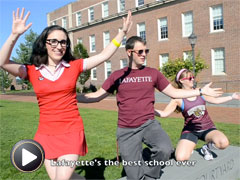
A screenshot of the student video contest winner, “Best School Ever”
Lafayette is also fortunate in being grounded in a very strong sense of community. As deeply as students, faculty, staff, and alumni love our beautiful campus, it is our people who make the college what it is. When I invited students to take part in an Inauguration video contest on the theme, “What Makes Lafayette . . . Lafayette,” I hoped to learn first-hand what students consider the true core of the institution. The entries were all terrific in different ways, but one thing they had in common was the emphasis on people. There were some scenic shots of the campus, but mostly they showed students: hanging out, studying in the library, dressing up for parties, singing a cappella, sitting on the Quad, or, in the words of one student, “just being our weird selves.” It was clear that “Lafayette” is not just a place, it is a way of being towards each other: a community. This sense of community is strongly rooted in Lafayette’s past, and is likely to be one of Lafayette’s primary assets as Lafayette and its peers face an uncertain future.
We all recognize that these are challenging times in higher education. The economic downturn not only depleted many colleges’ endowments, it focused renewed attention on tuition costs, and led to a keener sense of competition among colleges that compete to enroll strong students. At the same time, new developments in technology are raising fundamental questions about the nature of teaching and instruction, and the long-term future of current pedagogical models. The explosion of popular interest in MOOCs, massive open online courses, over the last 18 months has created unprecedented excitement and anxiety about the possibility of significant shifts in how education is offered. The online courses currently being offered through MIT, Harvard, Stanford, and other top universities number participants by the thousands. Beyond that, their symbolic impact has been enormous.
Some hail online courses as a breakthrough in efficiency that will make education more accessible and more affordable. Others see them as a “tsunami,” in a phrase used by Stanford’s president, that may herald the destruction of our current system of higher education by creating independent alternatives to degree-granting institutions. Both of the major MOOC providers, EdX and Coursera, now offer certificates of completion for certain courses that raise the possibility of a shadow credit system that could undermine the value of a conventional degree. Just last week, the University of Florida announced a completely online B.A. degree program. The University of Georgia is already offering a master’s degree for which students take MOOCs through MIT, then earn credit through testing from Georgia.
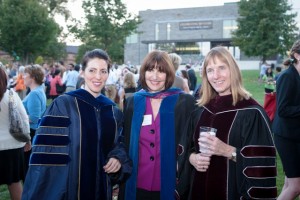
President Alison Byerly poses with Emily Musil Church, left, assistant professor of history, and Caryn McTighe Musil at the President’s Reception following the convocation ceremony on the Quad.
As we heard in this afternoon’s roundtable discussion, some commentators have seen an analogy between these developments in higher ed and what has already happened in the music industry, and in the newspaper industry. In both of these arenas, technology now allows consumers to go directly to content without going through the providers who had previously controlled access. Listeners downloading music directly from musicians’ websites, or readers finding the individual stories they want without having to purchase a complete publication, may prefigure a future in which students access educational content – online courses, or other forms of information – directly, without the mediation of a teacher or college. Media critics describe what has happened to record companies and newspapers as “unbundling”: elements that used to be sold as a package can now be acquired separately. It is not a stretch to imagine that the development of single courses that are independent of a specific curriculum could lead to a similar unbundling of the college or university model.
What does this mean for Lafayette? I believe it means that we have to be prepared to think hard about every element that makes up the Lafayette experience – the academic program, the athletic and extracurricular opportunities, the residential environment. It means we must understand and be able to justify the value of the complete package. Though the academic program is the core of that value, these other dimensions cannot be dismissible as frills or luxuries – they are integral to the overall educational and developmental experience. Those of us who teach and work here can see how students benefit from the opportunities for leadership, teamwork, collaboration, and friendship that Lafayette offers. We know that employers say that today’s graduates need both the analytic and communication skills that they hone through their coursework, and the interpersonal skills that come from living together – skills that are beginning to erode in an increasingly virtual social world.
The academic program of the future will need to be rigorous in its disciplinary training, as that is the quality that differentiates a structured curriculum, which offers a pathway through increasing levels of expertise, from the emerging à la carte approach to taking individual courses. A liberal arts curriculum creates a progression that requires you to explore and master whatever field you choose, in the context of a broad understanding of a range of disciplines. The value of the overall curriculum transcends the value of any individual course.
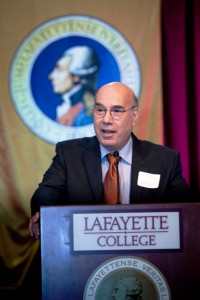
Jay Parini ’70, D.E. Axinn Professor of English and Creative Writing at Middlebury College, speaks during the luncheon.
But our program of the future will also need to be broadly interdisciplinary. This has been the trend in scholarship for many years, and many Lafayette faculty are already deeply engaged in developing new interdisciplinary programs in areas like Environmental Studies, Women’s and Gender Studies, Film and Media Studies, and International Affairs. Increasingly, students are approaching learning in terms of tasks or problems rather than fields. Their areas of interest do not necessarily map onto specific disciplines in which our faculty have their degrees or our departments are organized. Accommodating these interests will require both flexibility and a spirit of collaboration among faculty.
Teaching itself has changed dramatically over the last decade as a result of the way in which the new information economy of the internet alters both the teacher’s and the student’s relationship to course material, and it will be important for our faculty to have ongoing opportunities for pedagogical experimentation. It seems clear that the current distinction between what we call classroom learning and what is called out-of-class learning will rapidly become more and more porous. Already, some of the richest learning experiences at Lafayette link classroom learning to experiences exploring the geology of the Colorado Plateau, accompanying a history professor to South Korea and Japan, working with a clean water coalition in Haiti. And the “flipped classroom” model of pedagogy, in which students listen to lectures outside of class and class time is reserved for what used to be called “homework,” is starting to redefine what happens in the classroom itself.
I believe that in the future, teaching will not be defined in terms of a space, but in terms of a relationship. Teaching may not always take place in a classroom at defined times, but it will always involve teachers, and students. The important distinctions will not revolve around where learning takes place, but around what balance of instruction and independence it entails. I think we will need the boundary between in-class and out of class, academic and nonacademic learning to become less of a rigid wall and more of a permeable membrane if we are to retain the power to shape students’ entire educational experience. We may need to think creatively about curricular structures, about the different modes and venues in which faculty engage students, perhaps even about the college’s schedule and calendar, in order to create the kind of flexibility that I believe students will come to demand.
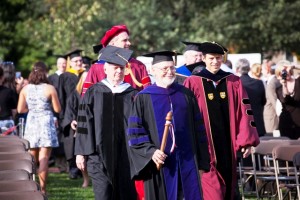
David Ellis, president emeritus of Lafayette, marched at the head of the delegates from colleges and universities during the Academic Processional.
In order for Lafayette to create a seamless and immersive learning experience for students, the academic program will need to be not just complemented by, but embedded in, a residential environment that supports the community values to which we aspire, and connects them to students’ academic and career goals. A range of housing options can give students many opportunities to develop their capacity for leadership, maturity, independence, and fun. The goal of our residential community should be to form strong bonds of friendship and mutual responsibility among all students, a goal that will be critical as we increase the diversity of our student body.
Such a residential community can provide a powerful platform for extending learning beyond the classroom, and for thinking about the connections between academic work and the skills developed through athletics, through volunteer work, through internship or work experiences. Lafayette’s ability to resist the common dichotomy, even hostility, between academic and professional preparation already differentiates us from many of our peers, and this will help us to move forward. I believe that students will become less and less tolerant of higher ed’s tendency to segregate these aspects of their experience, and that we should welcome their efforts at a holistic understanding of these critical dimensions of their lives. Students today want their studies to be relevant, and by the same token, they want their work to be meaningful. I believe students will be very attracted to an environment that integrates their academic, social, and professional development into a seamless experience and coherent pathway. Lafayette already displays excellence in each of these three areas. But within the fully connected, immersive environment of a truly three-dimensional liberal arts college, the whole will be stronger than the sum of its parts. In this model, Lafayette will be, not an ivory tower, but an integrated circuit, a dynamic network in which the student experience is energized by ongoing interchange between the educational environment and the world beyond. That, I believe, is the package that cannot be “unbundled.”
Why am I so sure that Lafayette is prepared to be a leader in this dynamic new environment? One of the things I have come to admire most about Lafayette is the way in which it has always chosen its own destiny and shaped its own identity. In my Convocation Address this fall, I talked about the founding of the College, and the decision of the founders to name it after the much-admired General Lafayette. While most colleges are named after their founders, or their locations, Lafayette College was named in a spirit of idealism for a person who represented qualities that its founders wished to honor. I see that legacy of self-determination as having a powerful impact on the College over the years.
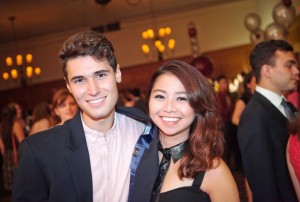
Students, alumni, and faculty danced the night away during the Inaugural Ball.
Lafayette College has never been afraid to take a leap of faith. David Skillman’s history of the College describes a second moment of truth in the life of the institution, a time in 1865 when it was on the verge of bankruptcy. In search of funding, President Cattell sought an interview with one Ario Pardee, a local businessman who knew nothing about Lafayette, and had never even been to Easton. But Cattell launched into a passionate description of the college and its financial challenges. “Why don’t you throw it up, if it doesn’t pay?” Pardee asked. “That’s what we do when we strike a vein of coal that doesn’t pay us to work.” President Cattell made an argument that might sound familiar to us today:
This led to an attempt on my part to show him that a college was carried on with a very different object in view from that in working a coal mine, or in carrying on any business operation where the return looked for was pecuniary gain; the purpose of liberal studies would be limited mainly to the sons of rich men, unless generous gifts for the support of professors should be made by those whom God had blessed with wealth and the disposition to use it for the benefit of their fellow man, and, I added,”such a man I take you to be” (Skillman 266).
Pardee asked how much was wanted, and Cattell, who had planned to ask for perhaps a thousand dollars, later wrote that “God put it in his heart” to ask then and there for what was truly needed: $20,000. Pardee wrote him a check for the full amount, and the College was saved (267).
This story holds many lessons for a new president. Cattell knew how to make an eloquent argument for the intrinsic, non-economic value of a liberal arts education. He also knew how to make a big ask.
Another critical moment in the College’s history came when the Board of Trustees voted, in 1969, to admit women to Lafayette. This decision was made after careful study and discussion within the community, but it, too, was a leap of faith, made in the face of concerns that expanding the size of the student body and admitting women would lessen the academic quality of admitted students, and that alumni anger at abandoning male-only education might hurt fundraising efforts. The chair of the board, Ralph Gotshall, admitted to the board: “I loved the College as a student and I have loved it through the years. And during all of that time Lafayette has been a men’s college. I am sentimental about that feature of the College and about many other features.” But he went on to add that as a trustee he had to put aside his personal feelings and “act in the best interests of the College and respond with an answer that will allow Lafayette College to continue as one of the best colleges in the country” (Gendebien 636-7).
There is much we can learn from this anecdote as well. I have said on many occasions that one of Lafayette’s greatest strengths is the dedication and commitment of its alumni. I have been very impressed by the depth of feeling that the College’s alumni have for the college and its traditions. I have been deeply moved by many stories that I have heard from alums about how much they learned and benefited from a particular course, or from a dedicated coach, or from a close-knit group of fraternity brothers.
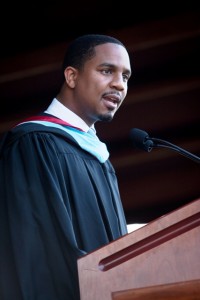
John F. McKnight, dean of Intercultural Development, spoke for the administration and staff during the convocation ceremony.
At times, I do hear a sense of fear that the Lafayette of today or tomorrow may somehow be less special. I sympathize with that concern, which comes from a deep affinity for the College, and I want to reassure you that you need not fear that we will lose sight of the underlying values that make Lafayette Lafayette. While the structures of the College may change, as they have over almost two centuries, its essential DNA will not. Nonetheless, we must be wary of allowing nostalgia to prevent evolution. We are not competing with the past; we are competing with the future. It is precisely Lafayette’s history of self-determination and its tradition of embracing change that make me confident that we can succeed in that future.
The challenge to the liberal arts offered by the popular media often takes the form of the question, how well does a liberal arts education prepare you for the real world? Lafayette’s history demonstrates a capacity for change that tells me that we can be pioneers in producing a model that explodes the false dichotomy between the ivory tower and “the real world.”
In the future, the answer to the question, “How well does Lafayette prepare you for the real world?” will be that Lafayette does not simply prepare you for the real world: Lafayette is the real world. Once you enter it, you will never have to leave.
Thank you.










